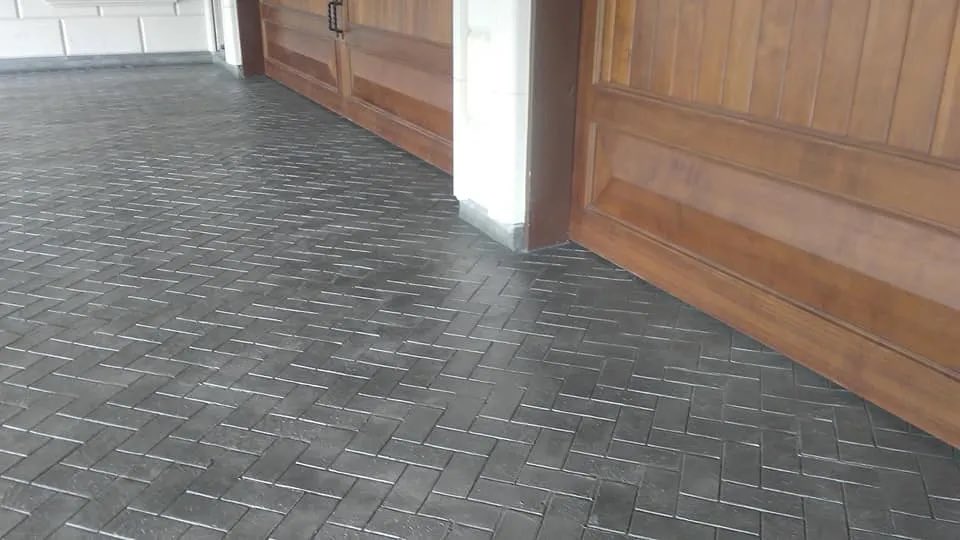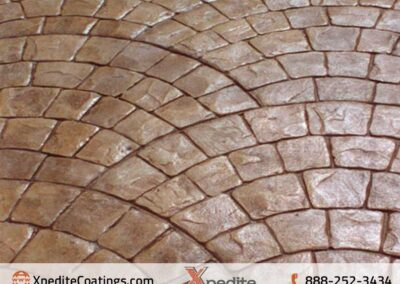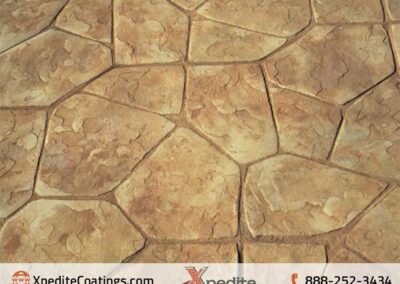Experience the Ultimate in
Stamped Concrete
A perfect blend of beauty and durability
STRIKING
RESILIENT
CUSTOMIZABLE
Bring your home to life
with stunning stamped
concrete designs
The concrete that stands out

Your home is your haven, and you deserve to have it reflect your unique style and personality. Xpedite Coatings specializes in creating customized stamped concrete designs that breathe new life into your outdoor living space.
With our expert craftsmanship and knowledge of stamped concrete techniques, we can deliver personalized solutions that enhance the look and feel of your home.
So whether you want a peaceful retreat to unwind or an inviting space to entertain your guests, we have the creative expertise to bring your vision to life.
Explore our creative
stamped concrete projects
Discover The Surprising Benefits of Stamped Concrete
If you’re a homeowner looking to improve the appearance and value of your property, stamped concrete is a solution worth considering.
Unlike traditional concrete or pavers, stamped concrete can mimic the look of luxurious materials like stone, brick, or tile and offers a highly customizable and durable option for various surfaces, including patios, walkways, driveways, and pool decks.
Traditional concrete can be dull and prone to cracking or settling. And paving stones can be costly and difficult to install. Stamped concrete addresses these issues by providing an innovative approach to designing and constructing beautiful, long-lasting surfaces.

Residential Stamped Concrete FAQs
What's the difference between stamped concrete and regular concrete?
Stamped concrete and regular concrete differ in terms of their appearance, texture, and method of installation. Here are some of the key differences:
- Appearance: Stamped concrete looks like other materials such as brick, stone, or tile. We can customize it to match the surrounding landscape or architecture. Regular concrete has a plain, gray appearance.
- Texture: Stamped concrete has a textured surface created by pressing a pattern or design into the wet concrete using specialized tools. We can finish regular concrete with a smooth or rough surface, depending on the desired look.
- Installation: We install stamped concrete over existing concrete using stamps or molds to create the desired pattern or design. The stamps are placed onto the wet concrete and pressed to create the pattern.
- Cost: Stamped concrete is generally more expensive than regular concrete because of the additional steps involved in creating the stamped pattern or design. The price may vary depending on the design’s complexity, the area’s size, and the location.
- Maintenance: Stamped concrete requires regular cleaning and resealing to maintain its appearance and protect it from the elements. Standard concrete may require some maintenance, such as patching or crack repair.
The fundamental difference between stamped and regular concrete is its appearance and texture. Stamped concrete mimics other materials, while traditional concrete has a plain, utilitarian look.
How long does stamped concrete last?
The lifespan of stamped concrete depends on various factors, such as the quality of the installation, the level of maintenance, and the weather conditions in the area.
However, when properly installed and maintained, stamped concrete can last for decades.
Stamped concrete is made of the same durable material as regular concrete. Properly installed and reinforced with steel can withstand heavy loads, weathering, and general wear and tear.
However, the stamped surface may wear down with heavy foot or vehicle traffic, exposure to harsh chemicals, and weather extremes.
Regular maintenance, such as cleaning and sealing, can help extend the life of stamped concrete.
The average lifespan of stamped concrete is around 25-30 years, but it can last longer with proper care.
To ensure your stamped concrete’s longevity, a qualified installer, such as Xpedite Coatings, must install it, follow a regular maintenance schedule, and avoid exposing it to heavy loads or harsh chemicals.
What is the cost difference between stamped concrete and other paving materials?
The cost of stamped concrete compared to other paving materials can vary depending on several factors, such as the size of the project, the complexity of the design, the materials used, and the project’s location.
However, here is a general overview of the cost differences between stamped concrete and other paving materials:
- Stamped concrete vs. plain concrete: Stamped concrete is typically more expensive than bare concrete because of the additional steps involved in creating the stamped pattern or design.
- Stamped concrete vs. brick: Stamped concrete can mimic the look of brick but is generally less expensive than actual bricks.
- Stamped concrete vs. pavers: Pavers are another popular paving material that can be more expensive than stamped concrete.
- Stamped concrete vs. natural stone: Natural stone is a high-end paving material that can be more expensive than stamped concrete.
Stamped concrete can be more cost-effective than other paving materials, especially if you want to achieve a specific design or pattern.
However, it’s essential to consider all the factors in your project, including installation and maintenance costs, before deciding which material to use.
What are the maintenance requirements for stamped concrete?
Stamped concrete is a durable and low-maintenance material. However, it still requires regular care to keep it looking its best.
Here are some basic maintenance requirements for stamped concrete:
- Cleaning: Regular cleaning is essential to prevent dirt and stains from building up on the surface of the stamped concrete. You can use a mild detergent and water to clean the surface or a pressure washer for tougher stains. Be sure to rinse the surface thoroughly after cleaning.
- Sealing: Sealing stamped concrete is vital to protect it from moisture, stains, and UV rays. Depending on the foot or vehicle traffic level, you should reseal the surface every two to three years or as needed.
- Repairing cracks: Stamped concrete may develop small cracks or chips. You should promptly correct any issues to prevent water from seeping in and causing further damage. You can use a concrete patching compound to fill in cracks or chips.
- Avoiding harsh chemicals: Avoid using harsh chemicals or de-icing salts on the surface of stamped concrete, as they can damage the surface or cause discoloration. If you need to use de-icing salts, use them sparingly and clean the surface thoroughly afterward.
- Protecting from heavy loads: Stamped concrete can withstand heavy loads, but it is still essential to protect it from excessive weight or pressure. Avoid parking heavy vehicles on the surface, and use caution when moving heavy objects.
Following these basic maintenance requirements can keep your stamped concrete looking beautiful and in good condition for many years.
What are the disadvantages of stamped concrete?
While stamped concrete is a popular and durable paving material, there are some potential disadvantages to consider before choosing it for your project.
Here are some of the most common disadvantages of stamped concrete:
- Slippery surface: The texture of stamped concrete can be slippery, especially when wet. This can be a safety hazard, particularly around pools, spas, or other areas where people may walk barefoot.
- Prone to cracking: Stamped concrete is susceptible to cracking, particularly in areas with heavy freeze-thaw cycles. While control joints can help prevent cracking, they can also detract from the appearance of the stamped surface.
- Fading and discoloration: Over time, stamped concrete may fade or discolor because of exposure to sunlight, weathering, or harsh chemicals. This can affect the overall appearance of the surface and may require additional maintenance.
- Maintenance requirements: Stamped concrete requires regular cleaning and resealing to maintain its appearance and protect it from the elements. This can be time-consuming and costly, especially for larger areas.
- Cost: Stamped concrete can be more expensive than other paving materials, such as plain concrete or asphalt, because of the additional steps involved in creating the stamped pattern or design.
- Limited customization: While we can customize stamped concrete to mimic the look of other materials, such as brick or natural stone, it may not be as versatile or customizable as other paving materials.
While stamped concrete can be a beautiful and durable paving option, weighing the potential disadvantages against the benefits is crucial before deciding on your project.
Can existing concrete be stamped or does it need to be newly poured?
Stamped concrete can be applied to newly poured concrete and existing concrete surfaces.
However, some factors should be considered before stamping an existing concrete surface.
The condition of the existing concrete is one of the most important factors to consider. The surface should be in good condition, with no significant cracks or damage.
In addition, it should be free of any debris or contaminants that could interfere with stamping. If the surface is in poor condition, it may need to be repaired or resurfaced before stamping.
Another factor to consider is the thickness of the existing concrete. If the concrete is too thin or has been weakened by years of wear and tear, it may not support the additional weight of the stamping process.
In addition, the existing concrete surface should be thoroughly cleaned and prepared before stamping to ensure good adhesion and a smooth surface for the stamped pattern. This may involve pressure washing, acid etching, or other cleaning methods.
Stamping an existing concrete surface can be a cost-effective way to update the look of your outdoor spaces.
However, it’s essential to work with a qualified contractor who can assess the condition of the existing surface and determine whether it’s suitable for stamping.























